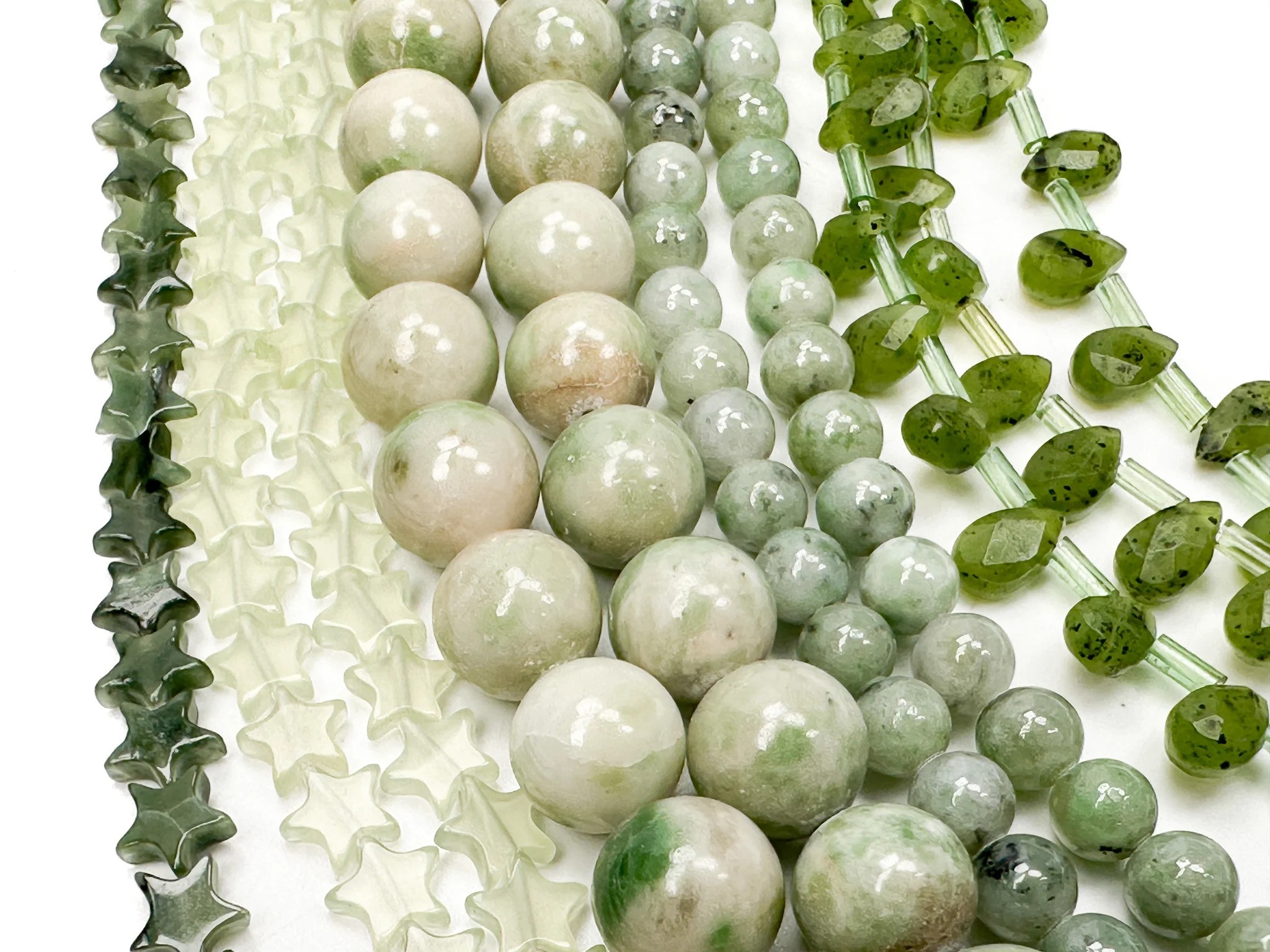Jadeite, with its mesmerizing hues ranging from the deepest greens to lavenders, reds, oranges, yellows, and even whites. This stone is captivating the hearts of jewelry lovers and craftsmen alike for long time. The precious gemstone, a form of jade, is famous for its beauty. It is also popular for its significant hardness and durability. This is making it an ideal candidate for various forms of jewelry. In this exploration, we delve into the traditional and modern uses of jadeite in jewelry making. We will discuss its significance across cultures, and how it continues to enchant in the contemporary jewelry scene.
A Glimpse into History
Jadeite, a gemstone treasured for its striking beauty and durability, has a rich history that spans across centuries and continents. Originating primarily in Myanmar (Burma), this has been revered in various cultures, especially within East Asia, for its symbolic significance and aesthetic appeal.
Historically, jadeite symbolized nobility, perfection, constancy, and immortality. In ancient China, it was considered the “imperial gem,” used in the finest carvings and often buried with the dead to symbolize purity and support spiritual journey in the afterlife. The Mayans and Aztecs in Central America also valued them highly, using it in masks, jewelry, and religious artifacts to denote status and for ceremonial purposes.
The discovery of jadeite sources in Myanmar during the 13th century significantly increased its availability and popularity. This is Its unique range of colors, from the most prized emerald-green jade known as “Imperial Jade” to shades of lavender, red, orange, yellow, blue, black, and white, has made it a sought-after material for artisans and collectors.
Trade routes established between Myanmar and China facilitated the flow of jadeite, embedding it deeper into Chinese culture. By the Ming and Qing dynasties, jadeite had become an integral part of Chinese artistry, evident in intricately carved pieces that are still celebrated today.
In the modern era, jadeite continues to be highly valued in the jewelry market, with its worth often surpassing that of diamonds. Its historical significance, combined with its beauty and rarity, ensures that jadeite remains a gemstone of unparalleled esteem.
Characteristics of Jadeite
Jadeite, a highly valued gemstone, is renowned for its unique characteristics that distinguish it from other minerals. One of its most notable properties is its color diversity. This can be found in a wide range of colors, including green, lavender, red, orange, yellow, blue gemstones, black, and white. The most prized color is a specific shade of green, often described as “emerald green” or “imperial green,”. This is both vibrant and deeply saturated.
In addition to its color spectrum, the stone is also appreciated for its exceptional toughness. This quality is due to the interlocking nature of its microscopic crystal structures, making it resistant to breaking and chipping. This toughness has made this gemstone a preferred material for both artistic carvings and practical objects throughout history.
The transparency of jadeite varies from completely opaque to semi-transparent, with the latter being more valuable. A higher degree of transparency often enhances the stone’s color intensity and is highly sought after.
Another characteristic of the stone is its texture, which can range from smooth to granular. A fine texture is usually more desirable as it contributes to the stone’s overall luster and aesthetic appeal.
Finally, the value of jadeite is significantly influenced by the gemstones by rarity. The highest quality stone is exceedingly rare, contributing to its status as one of the most coveted gemstones in the world.
Sourcing the Gemstone
Jadeite, a highly valued gemstone, is primarily sourced from Myanmar, which is home to the world’s most significant and high-quality deposits. This gemstone, known for its vivid colors and intense translucency, varies greatly in quality, with the top-grade “Imperial Jade” being the most sought after. The mining process is labor-intensive. This often involving the removal of large amounts of overburden to access the deposits.
After extraction, the raw jadeite is typically transported to markets and factories, where it is evaluated, cut, and polished. The city of Guangzhou in China is a major hub for the jadeite trade. Here skilled artisans transform rough stones into exquisite jewelry and art pieces.
The value of jadeite is determined by several factors including color, transparency, texture, and cut. With its deep cultural significance in Chinese society, jadeite remains a symbol of purity, grace, and beauty, making it highly prized not only in Asia but around the world.
Crafting Techniques of Jadeite
The crafting techniques are a blend of tradition and precision, requiring a deep understanding of the material’s properties.
The first step in crafting jadeite involves selecting the right piece of stone. Artisans look for quality in terms of color, transparency, and texture. Once selected, the rough jadeite is cut into workable pieces using diamond saws, considering the final product to avoid wastage of this precious material.
Carving is the next crucial step, where artisans bring their vision to life. This is done either by hand tools for detailed work or by rotary tools for bulk material removal. Hand carving is a skill that takes years to master, allowing for intricate designs that highlight jadeite’s natural beauty. The process requires patience and a steady hand, as jadeite is a hard stone.
Polishing is the final step, which brings out the jadeite’s luster. It involves using progressively finer abrasives until a smooth and shiny surface is achieved. This step is vital as it reveals the true color and translucency of the jadeite, making it ready for use in jewelry or as decorative objects.
Setting Jadeite in Jewelry
Jadeite’s versatility allows it to be set into almost any type of jewelry. Here are some common applications:
- Rings: Often set as cabochons or intricately carved pieces, jadeite rings can range from subtle elegance to bold statement pieces.
- Necklaces: Jadeite beads are popular for necklaces, offering a range of colors and sizes. Pendants featuring a single piece of carved jadeite are also highly prized.
- Bracelets and Bangles: Solid jadeite bangles are traditional in many Asian cultures, symbolizing protection and good fortune. Bracelets may feature smaller jadeite pieces or beads.
- Earrings: Jadeite can be fashioned into drops or studs, providing a touch of color and sophistication.
Symbolism and Cultural Significance
Jadeite, a gemstone of beauty and durability, holds profound symbolism and cultural significance, particularly in East Asian societies. Revered for millennia, jadeite is not just a material object but a symbol of purity, moral integrity, and protection. Its significance is deeply embedded in various cultural rituals, art, and philosophy.
In Chinese culture, jadeite is esteemed above all other stones, symbolizing the virtues of courage, wisdom, mercy, justice, and modesty. The Confucian principle of the ‘gentleman’s virtue’ is often compared to jadeite’s qualities – its warm luster reflecting inner beauty, its tough composition signifying resilience, and its smoothness representing benevolence. This gemstone plays a pivotal role in rites of passage, including birth, marriage, and death, embodying the hope for a noble life and a peaceful afterlife.
Moreover, jadeite is central to the concept of ‘Feng Shui,‘ believed to attract good luck and ward off evil spirits. Its various colors—each holding different meanings—enhance this belief. For instance, green gemstones is associated with growth and healing. The white stone represents purity and peace.
The Mayans and Aztecs also valued the stone highly, associating it with water and vegetation deities, hence symbolizing fertility and abundance. To them, jadeite was a divine stone that connected the earthly with the spiritual.
Jadeite’s enduring appeal lies in its deep cultural roots and the universal values it represents. It transcends mere aesthetic appreciation, embodying a rich tapestry of human beliefs, aspirations, and the eternal quest for harmony with nature and the divine.
Modern Appeal
Jadeite, with its rich heritage and enduring allure, continues to captivate modern enthusiasts worldwide. This precious stone, known for its striking shades ranging from the deepest greens to lavenders and even blues, holds a unique position in the world of gemstones. Its appeal in contemporary settings is multifaceted, rooted not only in its aesthetic beauty but also in its symbolic significance.
In the fashion industry, jadeite jewelry represents a blend of timeless elegance and modern sophistication. Designers frequently incorporate it into pieces that range from classic to cutting-edge, demonstrating its versatility. Moreover, collectors and connoisseurs prize jadeite for its rarity and the meticulous craftsmanship required to shape and polish this tough mineral.
Beyond aesthetics, jadeite carries deep cultural and spiritual meanings, especially within Asian traditions. It symbolizes purity, grace, and moral integrity, qualities increasingly sought after in today’s fast-paced world. This convergence of beauty, rarity, and symbolism ensures that jadeite remains a coveted gemstone, embodying a bridge between the ancient and the contemporary.
Caring for Jadeite Jewelry
Caring for jadeite jewelry requires a gentle approach to preserve its beauty and integrity. Jadeite, a valued gemstone for its aesthetic and durability, still needs mindful handling. To clean jadeite, simply use a soft, damp cloth. Avoid harsh chemicals or ultrasonic cleaners, as these can damage the stone’s surface. It’s also advisable to remove jadeite jewelry before engaging in activities that could expose it to scratches or harsh impacts, such as sports or heavy manual work.
When storing jadeite, keep it away from other pieces of jewelry that might scratch its surface. A soft pouch or a separate compartment in a jewelry box is ideal. Additionally, jadeite can be sensitive to extreme temperatures and direct sunlight, which can affect its color. Therefore, store it in a cool, shaded place.
Regularly check the settings of jadeite pieces, especially in rings and bracelets, to ensure the stones are secure. With these simple care steps, your jadeite jewelry will continue to enchant with its unique charm and beauty for generations.
Conclusion
Jadeite’s journey from ancient artifacts to modern masterpieces is a testament to its enduring allure. Its combination of unmatched beauty, cultural significance, and versatility in jewelry making continues to captivate both wearers and creators. As we look forward, jadeite remains a timeless treasure that bridges the past with the present, offering endless possibilities for future generations to appreciate and enjoy.
By understanding the rich history and intricate process behind crafting this jewelry, one gains a deeper appreciation for each piece’s unique beauty and significance. Whether through a simple bangle or an elaborately carved necklace, this stone brings a touch of elegance and profound meaning to any jewelry collection.





